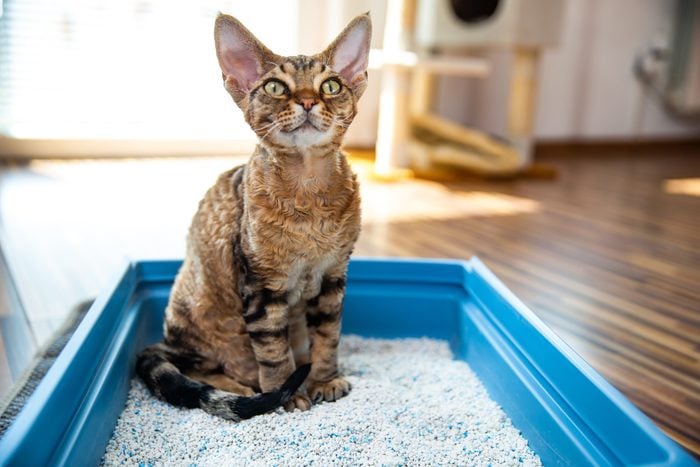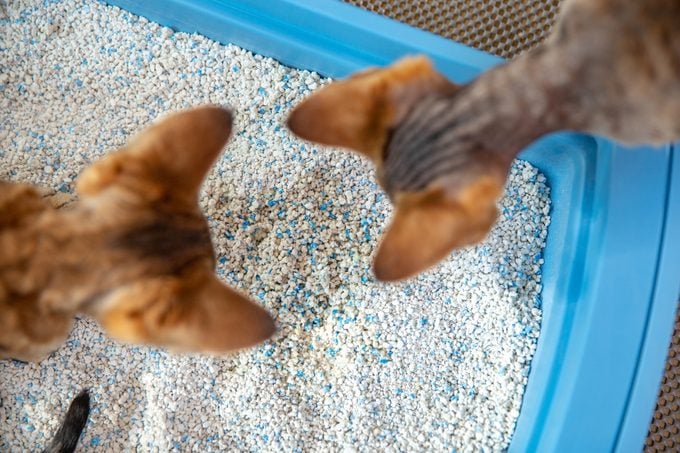Cat Litter Tips and Advice for Cat Owners

Cat litter is essential to your cat's health. Here's everything you should know about cat litter, according to experts.
Our editors and experts handpick every product we feature. We may earn a commission from your purchases.
Cat litter does more than just fill in your cat’s litter box. It can play a big role in maintaining your cat’s physical and behavioral health. The best cat litter boxes have the right kind of litter.
Cat litter helps you keep track how often your cat urinates, which can alert you to potentially dangerous issues like urinary tract infections. Having clean cat litter on hand can also prevent your cat from picking up bacteria from their litter box, or urinating elsewhere to avoid a dirty box.
But choosing and using cat litter isn’t as straightforward as it seems. We spoke with experts for the top cat litter tips and advice.
On This Page
What Is Cat Litter?
Cat litter is absorbent filler for the box where your cat does its business. It’s made of various materials, sometimes formulated with special ingredients to help absorb odor from cat urine and feces.
What Type of Cat Litter Should I Buy?
That depends on your cat’s preference. The following are the four most common types. Dr. Sara Ochoa of Whitehouse Veterinary Hospital in Texas recommends a low-dust variety. “The dusty litter can cause your cat to have upper respiratory issues,” she says.
-
Clay cat litter: The most popular kind, this comes in two forms: clumping and non-clumping. Clumping clay litter forms lumps when your cat urinates, making it easy to scoop out and dispose of. Non-clumping clay litter, on the other hand, tends to get rid of cat smells better thanks to its absorbing properties. Clay litter is often the most affordable.
-
Silica gel cat litter: This is made of tiny beads of sodium silicate sand, a porous material that allows it to absorb liquid. This kind a great for those sensitive to clay litter dust, although it tends to be more expensive.
-
Wheat cat litter: Similar to clay litter, wheat litter comes in clumping and non-clumping forms. The difference is that wheat litter is made from ground wheat, so it’s flushable. biodegradable and easy to dispose of. Expect to pay more for this type of litter.
-
Recycled paper cat litter: Those looking for a greener and more sustainable litter option may consider recycled paper litter, created from recycled newspapers. Recycled paper litter comes in granule or pellet form. Granule litter may be easier on your cat’s paws, while pellet litter tends to bring up less dust. Though good for the environment, recycled paper cat litter can be pricy.
Where Are the Best Places To Buy Cat Litter?
There are many places to buy it online and in-person. Here’s where to find it:
-
Big box stores: Top-name pet stores like PetSmart and Petco always carry different cat litter varieties. You can also find cat litter at retail giants like Target, Walmart, Kroger, CVS, and Meijer. In-store cat litter shopping offers the convenience of fast pickup, without the same deals as online shopping.
- Small pet stores: Smaller pet stores or brick-and-mortar shops aimed towards pets may carry cat litter. The benefits of shopping here include supporting local businesses, but you may not always get the discounts larger retailers can offer.
-
Online retailers: Amazon and Chewy quickly and easily deliver cat litter to your door, often on an automated schedule. You can also find more variety online and/or coupons to help you save. However, due to its weight, cat litter may be damaged in shipping, so it’s always best to open delivery boxes outside to prevent any indoor spills or mess.
-
Veterinary offices: Depending on your veterinarian, their office may sell cat litter. While this can be convenient, especially after an appointment, variety will likely be limited and the cat litter may be more expensive than in-store or online.
How Many Boxes Should I Typically Buy?
Buy one litter box per cat, plus one extra. If you own two cats, consider buying three litter boxes. Be sure it’s the type of litter box your cats prefer. Keep one or two packages of cat litter on hand depending on your available storage so you’re always ready for a litter change-out.
Where Should I Put a Litter Box?
This depends on the size of your home and the convenience of you and your pet. “You want to find a place that is quiet and out of the way so your cat has some privacy,” says Dr. Chyrle Bonk of Clearwater Valley Veterinary Clinic in Idaho. “But you also want an area that is easily accessible so your kitty doesn’t have to work hard to get there.”
Options include a bathroom, laundry room, kitchen, basement or mudroom. There are also types of litter boxes that double as modern furniture, Ochoa says, allowing you can consider your living room as well.
How Much Litter Goes Into the Box?
Many cat litter manufacturers recommend two to three inches. If your cat tends to dig deeper or make a mess, consider three to four inches instead.
How Do You Keep a Litter Box Clean?
“One of the best ways to keep cat litter boxes clean is to scoop at least once a day,” Bonk says. “Just keep it on a regular schedule, as you would if feeding them.” It’s smart to place a mat around a litter box to pick up excess litter or dust kicked up by your cat upon entering or exiting.
How Often Should I Change a Litter Box?
Change a litter box from once a week to once every few weeks. This helps keep your cat healthy and prevents potential behavioral issues, like inappropriate urinating. “Cats are more likely to use a litter box that is clean and easy to get to,” Bonk explains. “If a kitty has to work to get to their litter box or it’s constantly dirty, they are going to stop using it.” If you cat is peeing outside the litter box, make sure it’s clean.
How Do I Dispose of Cat Litter?
Scoop it directly into the trash or a special litter waste-collecting bin. The latter may be more convenient for temporarily storing cat litter waste until the bin is full, rather than putting it into a main trash can with each scoop.
If your cat litter is biodegradable, you can flush it. Otherwise, flushing is not recommended, as it can cause major plumbing issues over time.




